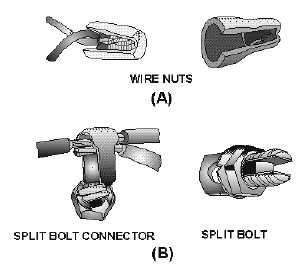2-9
Figure 2-10.—Wire nut and split bolt splices.
The split bolt splice (view B of figure 2-10) is used extensively to join large conductors. In the
illustration, it is shown replacing the knotted tap joint. The split bolt splice can also be used to replace the
"butted" splices mentioned previously when using large conductors.
Q5.
Why are the ends of the wire clamped down after a Western Union splice is made?
Q6.
Why are splices staggered on multiconductor cables?
Q7.
Where is the rattail joint normally used?
Q8.
Which type of splice is used to splice a lighting fixture to a branch circuit?
SPLICE INSULATION
The splices we have discussed so far are usually insulated with tape. The following discussion will
cover some characteristics of rubber, friction, and plastic insulation tapes.
Rubber Tape
Latex (rubber) tape is a splicing compound. It is used where the original insulation was rubber. The
tape is applied to the splice with a light tension so that each layer presses tightly against the one beneath
it. This pressure causes the rubber tape to blend into a solid mass. Upon completion, insulation similar to
the original is restored.
In roll form, there is a layer of paper or treated cloth between each layer of rubber tape. This layer
prevents the latex from fusing while still on the roll. The paper or cloth is peeled off and discarded before
the tape is applied to the splice.
The rubber splicing tape should be applied smoothly and under tension so no air space exists
between the layers. Start the first layer near the middle of the joint instead of the end. The diameter of the
completed insulated joint should be somewhat greater than the overall diameter of the original wire,
including the insulation.



